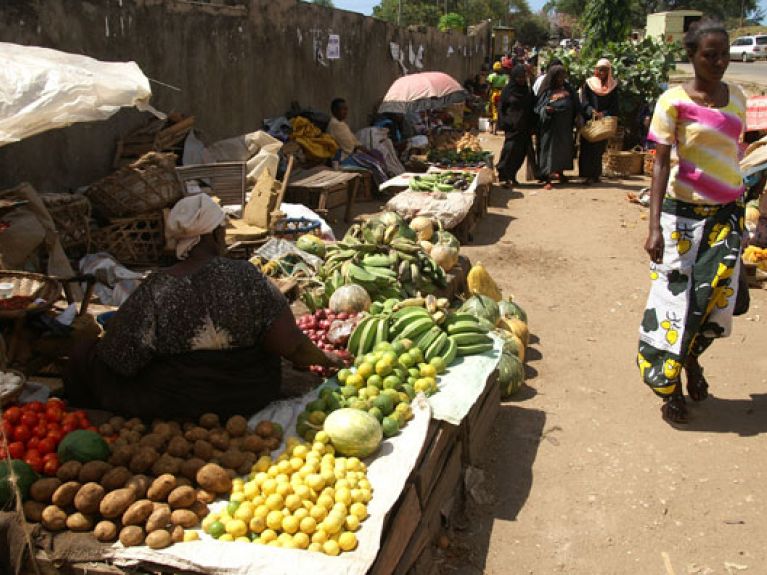A small tuber against hunger
New methods of cultivation and improved irrigation techniques: an initiative supports projects in Africa that aim to fight hunger and malnutrition.

A small orange-coloured tuber transformed Josephine Muchele’s life. She is a 50-year-old smallholder in Western Kenya. “Our harvest used to provide just enough for us to survive,” she reports. Then she came into contact with the Creadis aid organisation at a village meeting. It introduces the rural population to new vegetable and grain varieties and shows them how to successfully cultivate, process and market them. Muchele discovered the advantages of an orange-coloured sweet potato that is not very common in Kenya – and then cultivated it with great success. Previously she had grown a white, extremely fibrous sweet potato on her field. In comparison, the new tuber ripened much faster. The very first harvest produced twice as many sacks as before – and the price of each sack doubled. In the following year, Josephine Muchele was able to increase the area of land she farmed and buy a dairy cow. There was even enough money to pay school fees. “At last, all my grandchildren can go to school,” she reports.
Since the beginning of 2015, Creadis and other local aid organisations have been supported by a special initiative of the German Federal Ministry for Economic Cooperation and Development (BMZ) called One World, No Hunger. The objective of the special initiative is to overcome hunger and malnutrition. “At the same time, it aims to work with developing countries to create the conditions that will enable future generations to feed themselves – in spite of a steadily growing world population,” explains a ministry spokesperson. In 2015 the G7 states set themselves the goal of freeing 500 million people from hunger and malnutrition by 2030 in cooperation with partner states.
Africa is the focus of the special initiative since the challenges here are especially great. In sub-Saharan Africa nearly one in four people go hungry. In total, 795 million people worldwide are undernourished and a further two billion people are malnourished.
In its fight against hunger the special initiative focuses on different areas. Among other things, it supports projects that aim to restore soil fertility. It funds schemes to advance innovations in the food and agricultural sector as well as projects that reduce the risk of famine. This is the case, for example, in Mali, where acute famines repeatedly occur. One special initiative project enables the population to find out about more efficient irrigation methods; it has also repaired wells and provided pumps and high-quality seeds. This contributes to higher yields of rice, vegetables and pulses – and also strengthens people’s ability to combat famine.
The initiative funds projects in Malawi too. Many people in the southern African country predominantly eat maize. Although that fills you up, it does not supply enough nutrients and trace elements. Malnutrition has a detrimental effect on the growth and the mental development of children. Many pregnant women also suffer negative effects. In one project, health services advise mothers and pregnant women how they can improve their families’ nutrition. They learn from agricultural consultants how they can cultivate fruit, tubers and pulses. In addition, children receive a nourishing school meal. In the next two years, 15,000 mothers and 25,000 primary school and preschool children will benefit from the project.
Simone Pott, spokesperson of Welthungerhilfe, knows just how important support for the rural population is. “The people here live exclusively from what they grow,” says Pott. “They often have no possibility of earning money which they could then use to buy food.” Three quarters of the people who suffer from hunger live in the country. Women and children are especially affected. “Women, in turn, play a very important role in ensuring children receive a balanced diet and are therefore less susceptible to illnesses,” says the Welthungerhilfe spokesperson. That’s why they need to be made aware of how important, for example, traditional fruits and vegetables are. Simone Pott regards increased agricultural productivity as an additional approach to the fight against hunger. “Previously, large parts of the harvest have often been lost as a result of incorrect storage.” In addition, for example, yields could be increased by again using old, regional seed varieties that are more drought-resistant.
The One World, No Hunger special initiative also funds projects that develop and promote methods for improving postharvest handling. At the Green Innovation Centre in Zambia, for example, farmers can find out how to better store their peanut crop and thereby protect it against mould. Green Innovation Centres for the Agriculture and Food Sector are part of a programme that was initiated by the BMZ and is active in various African countries.
One World, No Hunger will be investing a total of roughly 430 million euros in 2016. So far projects worth 1.1 billion euros have been realised. This involves additional funds that supplement the BMZ’s commitment to rural development and food security.
This support opens up totally new prospects for people like Josephine Muchele in Kenya. The farmer already has many ideas for new areas of business. And she has a dream: “I would like to buy another piece of land for my children so that they can grow the new sweet potato just like me.” ▪

